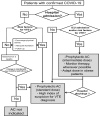Pulmonary embolism in patients with coronavirus disease-2019 (COVID-19) pneumonia: a narrative review
- PMID: 32953201
- PMCID: PMC7492788
- DOI: 10.1186/s13613-020-00741-0
Pulmonary embolism in patients with coronavirus disease-2019 (COVID-19) pneumonia: a narrative review
Abstract
Background: Preliminary reports have described significant procoagulant events in patients with coronavirus disease-2019 (COVID-19), including life-threatening pulmonary embolism (PE).
Main text: We review the current data on the epidemiology, the possible underlying pathophysiologic mechanisms, and the therapeutic implications of PE in relation to COVID-19. The incidence of PE is reported to be around 2.6-8.9% of COVID-19 in hospitalized patients and up to one-third of those requiring intensive care unit (ICU) admission, despite standard prophylactic anticoagulation. This may be explained by direct and indirect pathologic consequences of COVID-19, complement activation, cytokine release, endothelial dysfunction, and interactions between different types of blood cells.
Conclusion: Thromboprophylaxis should be started in all patients with suspected or confirmed COVID-19 admitted to the hospital. The use of an intermediate therapeutic dose of low molecular weight (LMWH) or unfractionated heparin can be considered on an individual basis in patients with multiple risk factors for venous thromboembolism, including critically ill patients admitted to the ICU. Decisions about extending prophylaxis with LMWH after hospital discharge should be made after balancing the reduced risk of venous thromboembolism (VTE) with the risk of increased bleeding events and should be continued for 7-14 days after hospital discharge or in the pre-hospital phase in case of pre-existing or persisting VTE risk factors. Therapeutic anticoagulation is the cornerstone in the management of patients with PE. Selection of an appropriate agent and correct dosing requires consideration of underlying comorbidities.
Keywords: COVID-19; Pulmonary embolism; SARS-CoV-2; Thromboprophylaxis; Venous thromboembolism.
© The Author(s) 2020.
Conflict of interest statement
Competing interestsThe authors declare that they do not have conflict of interests in relation to this manuscript.
Figures


References
Publication types
LinkOut - more resources
Full Text Sources
Miscellaneous

